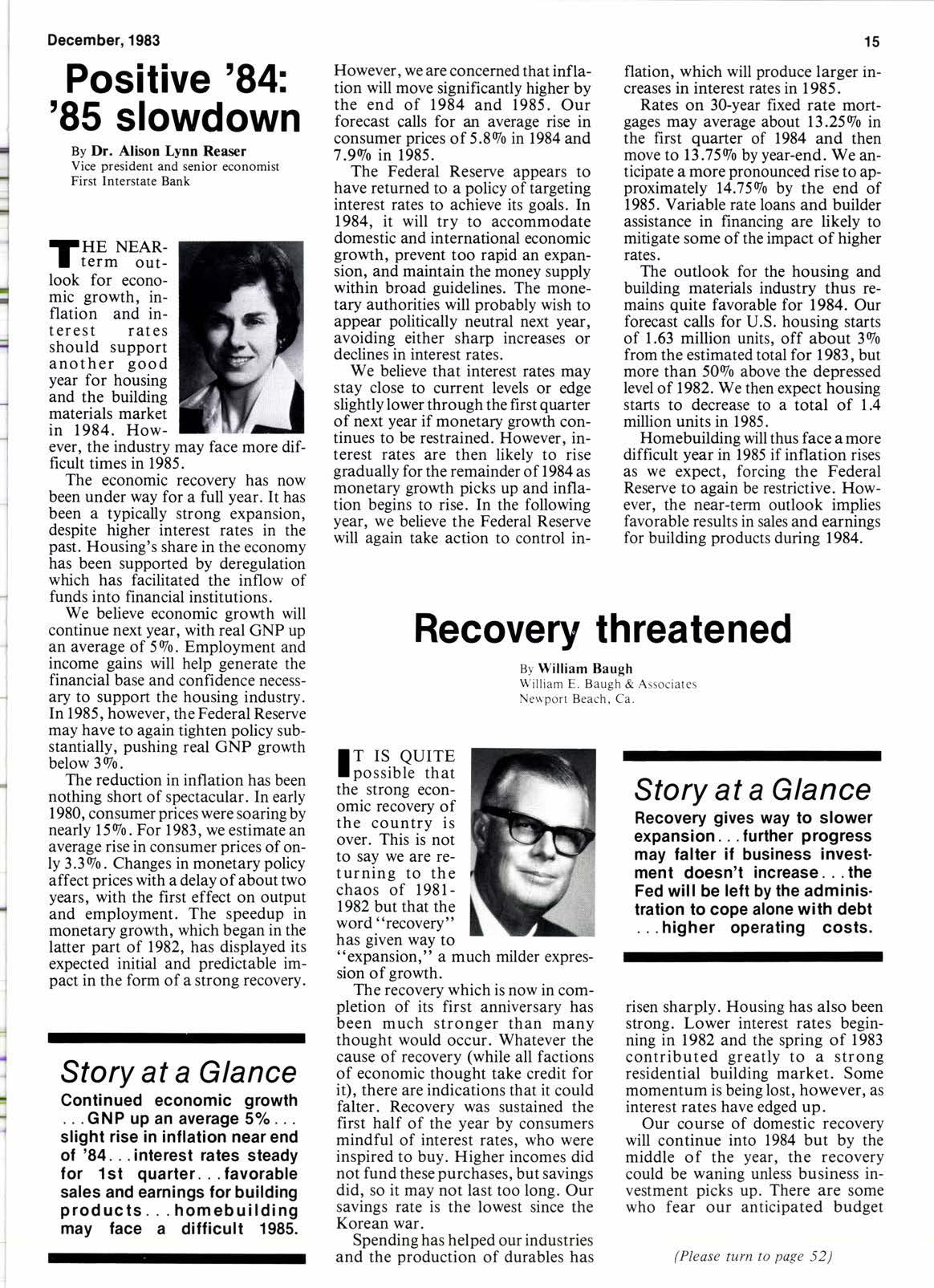
2 minute read
Positive '84: '85 slowdown
By Dr. Alison Lynn Reaser Vice president and senior economist First Interstate Bank
TJIF";*"*,1: look for economic growth, inflation and interest rates should supportanother good year for housing and the building materials market in 1984. However, the industry may face more difficult times in 1985.
The economic recovery has now been under way for a full year. It has been a typically strong expansion, despite higher interest rates in the past. Housing's share in the economy has been supported by deregulation which has facilitated the inflow of funds into financial institutions.
We believe economic growth will continue next year, with real GNP up an average of 590. Employment and income gains will help generate the financial base and confidence necessary to support the housing industry. In 1985, however, theFederal Reserve may have to again tighten policy substantially, pushing real GNP growth below 390.
The reduction in inflation has been nothing short of spectacular. In early 1980, consumer prices were soaring by nearly I 5 9o For 1983, we estimate an average rise in consumer prices of only 3.390. Changes in monetary policy affect prices with a delay of about two years, with the first effect on output and employment. The speedup in monetary grofih, which began in the latter part of 1982, has displayed its expected initial and predictable impact in the form of a strong recovery.
Story at a Glance
Continued economic growth GNP up an average 5% slight rise in inflation near end of '84. . .interest rates steady lor 1st quarter. lavorable sales and earnings for building products. homebuilding may face a difficult 1985.
However, we are concerned that inflation will move significantly higher by the end of 1984 and 1985. Our forecast calls for an average rise in consumer prices of 5.890 in 1984 and 7.990 in 1985.
The Federal Reserve appears to have returned to a policy oftargeting interest rates to achieve its goals. In 1984, it will try to accommodate domestic and international economic grofih, prevent too rapid an expansion, and maintain the money supply within broad guidelines. The monetary authorities will probably wish to appear politically neutral next year, avoiding either sharp increases or declines in interest rates.
We believe that interest rates may stay close to current levels or edge slightly lower through the first quarter of next year if monetary growth continues to be restrained. However, interest rates are then likely to rise gradually forthe remainder of 1984 as monetary growth picks up and inflation begins to rise. In the following year, we believe the Federal Reserve will again take action to control in- flation, which will produce larger increases in interest rates in 1985.
Rates on 3O-year hxed rate mortgages may average about 13.2590 in the first quarter of 1984 and then moveto 13.75s/o byyear-end. Weanticipate a more pronounced rise to approximately 14.750/o by the end of 1985. Variable rate loans and builder assistance in financing are likely to mitigate some of the impact of higher rates.
The outlook for the housing and building materials industry thus remains quite favorable for 1984. Our forecast calls for U.S. housing starts of 1.63 million units, off about 3Vo from the estimated total for 1983, but more than 5090 above the depresed level of 1982. We then expect housing starts to decrease to a total of 1.4 million units in 1985.
Homebuilding will thus face a more diffrcult year in 1985 if inflation rises as we expect, forcing the Federal Reserve to again be restrictive. However, the near-term outlook implies favorable results in sales and earnings for building products during 1984.










